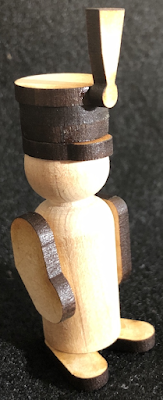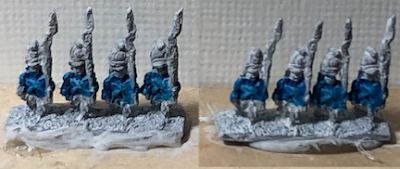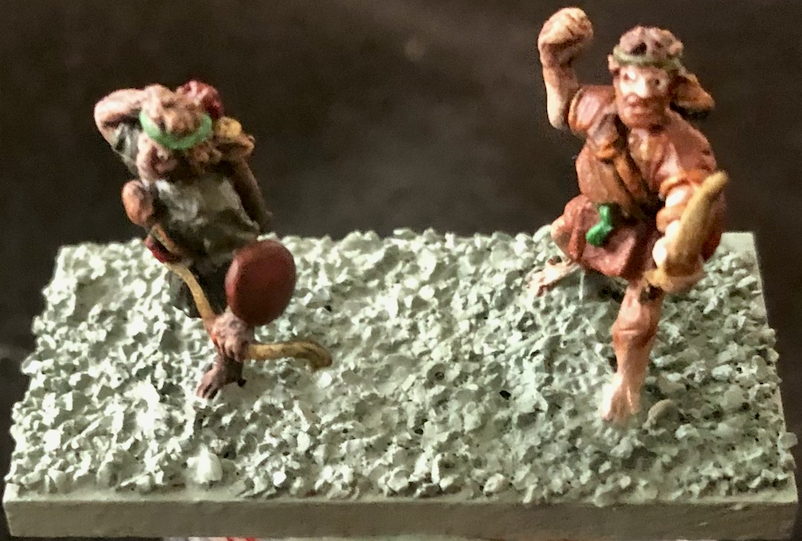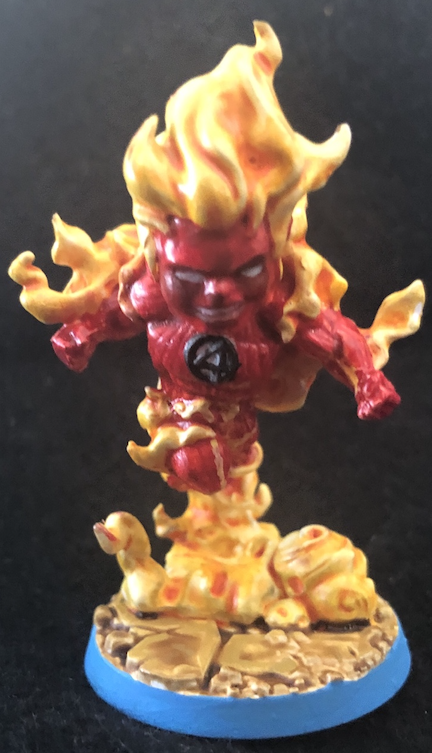I have been doing a lot of painting of late, as part of my trying to figure out which scales to keep and which to shed.
Wooden Warriors – French (Napoleonic) Marine of the Imperial Guard
One only my Wooden Warriors blog I finally made two posts. The first was about how to use my laser cutter for something other than making paint racks and wooden bases; I decided to take a different approach to making Napoleonics shakos. I did a test and then painted up this French Marine of the Imperial Old Guard.
6mm Napoleonics Painted with Citadel Contrast Paint
Someone on one of the Facebook groups had asked about whether anyone had tried painting 6mm miniatures with Citadel Contrast Paint. As I had done some 15mm in the past, I decided to give it a go and report on the results. I decided to try a harder subject that the standard Space Marines or Space Elves; I went with Napoleonic-era Bavarian troops.
First a couple of notes. Firstly, 6mm closeups always look horrible; they just do. You really find out how shaky your hands are when you photograph 6mm troops. You can actually see details, flaws really, that you just don't see when you are looking at them about 1' away (or farther).
I started by priming the miniatures white with Pro-Acryl white primer. It is a nice, thin white that does not clog the detail, which is important with 6mm, especially if you are going to use Contrast Paints or Speedpaint. As there are older Baccus sculpts, they are very rough and thus will take these types of paints well.
Here is what they look like, fully painted. (I later took a little more white to the trousers and cross belts to make them more solid.)
Overall I was good with the results, but I really need to look at the results of figures that are more crisp. The older Baccus sculpts are very 'rough' and I was not keen on them. But I love the newer sculpts. Also, using the gray Contrast Paint as a replacement for metallic paint is not really a good idea, so I would change that and go back to a gunmetal color.
Next up are Xyston 15mm Later Achmaemenid Persians. I bought a ton of Xyston 15mm ancients when Brookhurst Hobbies had a clearance sale and I have had them heaped in a pile of shame every since. (Greek Hoplite and Thracians are two of the armies that I vowed I would have a large collection on, one day. They would practically all be Xyston miniatures too.)
I started off airbrushing on a Zenithal primer. I started with Pro-Acryl black and fully covered the miniature. Then I swapped in Pro-Acryl white primer without cleaning the pot, knowing that it would come out gray. I liberally covered the figures, leaving only the undersides untouched. Finally I drybrushed white on top to pick up the highlights.
Next I started carefully laying down the contrast colors, doing white touchups for areas where a darker color was laid down over an area where a lighter color was intended.
Here are the final results. For the most part I had to use light, opaque highlights over the areas with Contrast Paints to remove the 'tide pools' and 'coffee stains'. The newer Contrast Paints that have less contrast, such as the bright yellow on the purple and yellow figures, as opposed to the yellow-brown on the other figures. The former did not require yellow highlights (I actually shaded with Shade Paints), while the latter definitely did.
Overall I think the older Contrast Paints are too 'brutal' for 15mm. It is better to go with a base color and use Shade Paint or a wash to collect in the recesses. If you want three colors go with a base color as a mid-tone, highlight with a lighter color (use more contrast between the base and the highlight than you would with 28mm figures), and then wash with a darker color. The tint from the wash will tone down the mid-tone and highlight, bringing down the contrast, and match well with the shadow color it gives the recesses. For me, Contrast Paints do not seem to be the solution for 15mm. It flows too well for the scale.
The last experiment came from watching a video by Bunker6. He paints a lot of Games Workshop Epic Warhammer 40,000 figures – roughly 6mm – and he puts a lot of detail into them. I decided to see if I still had my eye and hand (because if not, the unpainted 6mm were going to be on the chopping block).
I started with the new Imperial Fist Yellow Contrast Paint because: 1) these are meant to be Imperial Fists; 2) I don't have any other yellow that is that exact hue; and 3) these are supposed to be one of the new single pigment colors that cover well and are low contrast (which is ironic for a 'contrast paint'). First off, it does cover well and the flow characteristics are generally nice, but the smaller the scale the less you want your paints to flow. As this was my base coat for the model, and nothing was going to be a lighter color, I did not care that it flowed off of the areas where I put the brush. If anything, it ensured that I did not miss a spot.
Personally I think I put in a little too much detail, but nonetheless I went forward with the exercise because I wanted to see whether the effort was wasted or not. I already consider this picture too zoomed in for tabletop view, but not so close that it looks closer than bent arm's length (the range most people generally use when they pick up a stand to look at it). I can still see the attempt at details, like the grey behind the knees (rubber parts in the armor), the black stripe on the helmet, the red glowing eyes, and the black and silver bolt gun. I can also see one other detail that you probably don't see and that is only because I intentionally painted it: I painted a yellow highlight color and a yellow shade color. Is it worth it? Not sure. But I answered my question: I can still paint 6mm troops to an acceptable table standard with my eyes and hand.
A Note About Army Painter Speedpaint
My experiments with Army Painter Speedpaint has been disappointing. Largely because they are not really acrylic paints, but some form of 'resin' paint. Water causes them to reactivate, so adding acrylic highlights over them causes them to partially blend with the color being painted on while also popping the color off of the primer, exposing the white (or whatever the primer color was) below. Not a good effect because you cannot really control it. Dana Howl (YouTuber miniature painter) was the first that I saw that suggested the way to deal with this was to mix your acrylic paint with either Speedpaint Medium or another Speedpaint color, effectively turning it into a custom Speedpaint color. A lot of people must be doing this because Speedpaint Medium is very hard to find right now and where you can find it, it is double its normal price.
One thing I have found out for sure is to not mix Speedpaint with acrylic mediums like matte medium, glaze medium, metallic medium, etc. It makes it into a gloppy mess that spreads even worse than Speedpaint, that Flow Aid or water does not seem to fix.
At this point I see Speedpaint as an 'all or nothing' solution.
Sad News
More than 15 years ago, while still trying to build a gaming club in Sierra Vista, Arizona, I was searching The Miniatures Page for players who might be within driving range, but were to the east (i.e. we were closer than Tucson, Arizona) and thus underserved, gaming-wise. I found Marv and Betsy Schmid and despite them being five hours away (in Deming, New Mexico) they said that they would be happy to hop in their camper and come to Sierra Vista and teach us this game called De Bellis Antiquitatus (a.k.a. DBA). They had numerous armies and all the terrain we would need. It was a smashing success, such that many of us started collecting DBA armies. It also led to the discovery of HOTT, me creating American War of Independence version of DBA (DB-AWI 2008) and HOTT (HOTR 2009), and even a blog (now inactive) about my DBA games.
Over the years my wife Rita and I have alternated visiting with Marv and Betsy, us going to their house or they coming to ours. Gaming buddy Don and I once dropped by on the way to a DBA tournament in Albuquerque, New Mexico for inspiration and last minute tips. We even went to a state park with a lake together to swim, camp, and game.
Part of what I have been doing of late is re-connecting with people that I haven't spoken to during the lockdowns, especially those that are not in my immediate area. That has led to some great conversations with people across the country and around the world, but sometimes it leads to sad news. It took finding an old mobile phone, recharging it, and retrieving the phone number I failed to transfer over to my new phone to finally reconnect to Marv and Betsy, only to find out that Marv had died last May of brain cancer.
Needless to say, Betsy is still trying to cope with the loss, but Marv had a large wargaming collection and she was trying to get a hold of me in hopes that I would take it off her hands. Right when I am trying to downsize my own collection… So, right after I retire next month I am going to head to Deming to inventory his collection, see what I think I can "move to a good home", i.e. what is sellable, and work with her on managing the sale of his collection. Hopefully I can sell things off on Facebook, The Miniatures Page, Fanaticus, and eBay and send her checks periodically. I know it will be a lot of work, but it is a bit of repayment to a couple that showed us a part of this great, fragmented hobby that ended up being a big part of my wargaming experience (and this blog), plus it will show me how to reduce my own collection.
In a way this is something I have been considering, and although it is a bit morbid, it is something we need to consider. What will happen to your collection when you pass? Are you sure the kids will take it? Are you sure your friends will? Do they know they are going to be tagged to disposed of your collection? Is your wife expecting to recover some of the costs of your hobby? Does she know that you "invested" in a depreciating asset? Does she know who to contact about your collection? Does she know how to sell it? Does she know a reasonable price? (Do you? When was the last time you sold?)
I posted a message on a DBA forum on Facebook to try and get a sense of what the market for painted 15mm DBA armies is. Ten years ago I used to scour eBay, Fanaticus, and TMP for painted DBA armies and paid what I felt was a premium buying them. But I stopped playing DBA after 3.0 fragmented the player base. Like Flames of War 3rd and 4th Editions, I just couldn't get into the next edition, despite buying the new rules. I was done. And with that exit went my knowledge of how viable the market was.
Fortunately, it appears that the market is still good. Not only are people still playing DBA 2.2, 2.2+, and 3.0, there is a new derivative called Triumph, but it appears that Art de la Guerra (ADLG) using the standard DBA basing. So I feel better about taking on his DBA collection to sell for her. His WW II and Arab-Israeli micro armor, however, jet age Check Your 6 aircraft collection, however, are a different story. But just like the old joke about how to eat an elephant (one bite at a time), so to with how to move someone's lifelong collection. Enough whining!
Here's to you Marv. You will be missed.




















